Chapter 6
Mathematics Knowledge and Operations
IN THIS CHAPTER
Getting more terminology under your belt
Revisiting high school: Algebra and geometry review
Performing calculations without the calculator
Perfecting your way to a higher score
Albert Einstein once said, Do not worry about your problems with mathematics. I assure you mine are far greater. The good professor obviously never faced an upcoming ASVAB exam! Okay, just kidding. You dont have to be a mathematical theoretician to score well on the Mathematics Knowledge subtest. This subtest asks questions about basic high school mathematics. No college or graduate degrees needed.
On the paper version of the ASVAB, the Mathematics Knowledge subtest consists of 25 questions, and you have 24 minutes to complete the subtest. The CAT-ASVAB offers 16 questions in 20 minutes. You dont necessarily have to rush through each calculation, but the pace you need to set doesnt exactly give you time to daydream. You have to focus and concentrate to solve each problem quickly and accurately. And no calculators allowed!
Most of the time, the Mathematics Knowledge subtest contains only one or two questions testing each specific mathematical concept. For example, one question may ask you to multiply fractions, the next may ask you to solve a mathematical inequality, and the question after that may ask you to find the value of an exponent. (If youre freaked out by the last sentence, calm down. I cover these concepts in this chapter.)
All this variety forces you to shift your mental gears quickly to deal with different concepts. You can look at this situation from two perspectives. These mental gymnastics can be difficult and frustrating, especially if you know everything about solving for x but nothing about finding a square root. But variety can also be the spice of life. If you dont know how to solve a specific type of problem, any oversight may cause you to get only one or two questions wrong.
 To qualify for certain jobs in the military, you have to score well on the Mathematics Knowledge subtest. You also have to do well on this subtest, which is part of the AFQT discussed in to find out more about the subtest scores needed for specific military jobs.
To qualify for certain jobs in the military, you have to score well on the Mathematics Knowledge subtest. You also have to do well on this subtest, which is part of the AFQT discussed in to find out more about the subtest scores needed for specific military jobs.
In this chapter, I go over the basic arithmetic, algebra, and geometry you need to know. This info also comes in handy when solving word problems on the Arithmetic Reasoning subtest, which I cover in .
Just When You Thought You Were Done with Vocab: Math Terminology
Math has its own vocabulary. In order to understand what each problem on the Mathematical Knowledge subtest asks, you need to understand certain mathematical terms:
- Integer: An integer is any positive or negative whole number or zero. The ASVAB often requires you to work with integers, such as 6, 0, or 27.
Factors: Factors are integers (whole numbers) that can be divided evenly into another integer. To factor a number, you simply determine the numbers that you can divide into it. For example, 8 can be divided by the numbers 2 and 4 (in addition to 1 and 8), so 2 and 4 are factors of 8.
Numbers may be either composite or prime, depending on how many factors they have:
- Composite number: A composite number is a whole number that can be divided evenly by itself and by 1, as well as by one or more other whole numbers; in other words, it has more than two factors. Examples of composite numbers are 6 (whose factors are 1, 2, 3, and 6), 9 (whose factors are 1, 3, and 9), and 12 (whose factors are 1, 2, 3, 4, 6, and 12).
- Prime number: A prime number is a whole number that can be divided evenly by itself and by 1 but not by any other number, which means that it has exactly two factors. Examples of prime numbers are 2 (whose factors are 1 and 2), 5 (whose factors are 1 and 5), and 11 (whose factors are 1 and 11).
Exponent: An exponent is a shorthand method of indicating repeated multiplication. For example,  can also be expressed as 152, which is also known as 15 squared or 15 to the second power. The small number written slightly above and to the right of a number is the exponent, and it indicates the number of times you multiply the number it accompanies by itself. Note that 152 (
can also be expressed as 152, which is also known as 15 squared or 15 to the second power. The small number written slightly above and to the right of a number is the exponent, and it indicates the number of times you multiply the number it accompanies by itself. Note that 152 ( ), which equals 225, isnt the same as
), which equals 225, isnt the same as  (which equals 30).
(which equals 30).
To express  using this shorthand method, simply write it as 153, which is also called 15 cubed or 15 to the third power. Again, 153 (which equals 3,375) isnt the same as
using this shorthand method, simply write it as 153, which is also called 15 cubed or 15 to the third power. Again, 153 (which equals 3,375) isnt the same as  (which equals 45).
(which equals 45).
- Base: A base is a number thats used as a factor at least two times its a number raised to an exponent. For instance, the term 43 (which can be written
 , and in which 4 is a factor three times) has a base of 4.
, and in which 4 is a factor three times) has a base of 4. - Square root: The square root of a number is the number that, when multiplied by itself (in other words, squared), equals the original number. For example, the square root of 36 is 6. If you square 6, or multiply it by itself, you produce 36. (Check out later in this chapter.)
Factorial: A factorial is represented by an exclamation point (!). You calculate a factorial by finding the product of (multiplying) a whole number and all the whole numbers less than it down to 1. So 6 factorial (6!) is  .
.
 A factorial helps you determine permutations all the different possible ways an event may turn out. For example, if you want to know how many different ways six runners could finish a race (permutation), you would solve for 6!
A factorial helps you determine permutations all the different possible ways an event may turn out. For example, if you want to know how many different ways six runners could finish a race (permutation), you would solve for 6!  .
.
- Reciprocal: A reciprocal is the number by which another number can be multiplied to produce 1; if you have a fraction, its reciprocal is that fraction turned upside down. For example, the reciprocal of 3 is
 . If you multiply 3 times
. If you multiply 3 times  , you get 1. The reciprocal of
, you get 1. The reciprocal of  is
is  (which is the same thing as 6);
(which is the same thing as 6);  . The reciprocal of
. The reciprocal of  is
is  . Get the idea?
. Get the idea? Rounding: Rounding is limiting a number to a few (or no) decimal places. You perform rounding operations all the time often without even thinking about it. If you have $1.97 in change in your pocket, you may say, I have about two dollars. The rounding process simplifies mathematical operations.

Next page
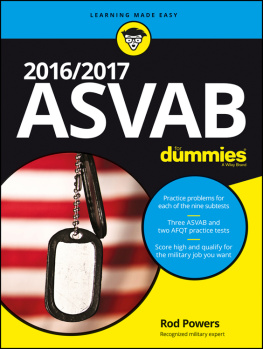
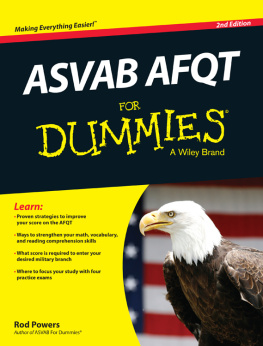
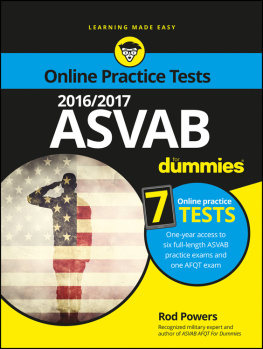


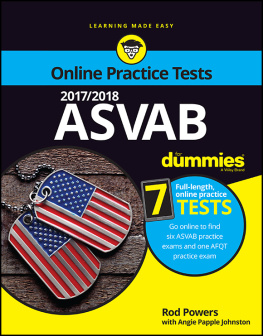
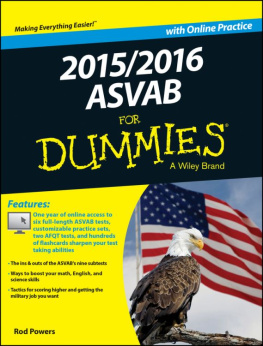
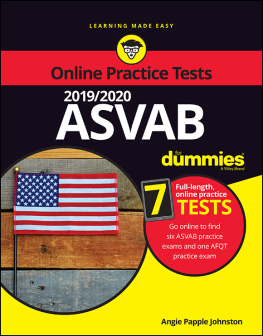
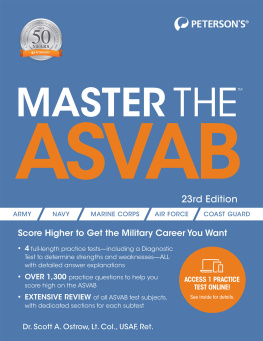
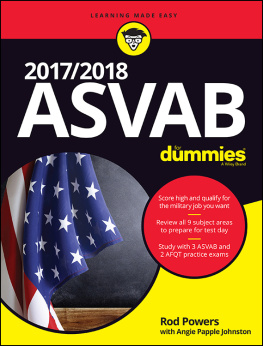


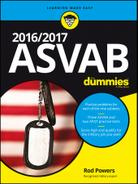
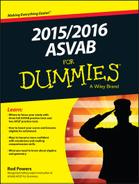
 To qualify for certain jobs in the military, you have to score well on the Mathematics Knowledge subtest. You also have to do well on this subtest, which is part of the AFQT discussed in to find out more about the subtest scores needed for specific military jobs.
To qualify for certain jobs in the military, you have to score well on the Mathematics Knowledge subtest. You also have to do well on this subtest, which is part of the AFQT discussed in to find out more about the subtest scores needed for specific military jobs. can also be expressed as 152, which is also known as 15 squared or 15 to the second power. The small number written slightly above and to the right of a number is the exponent, and it indicates the number of times you multiply the number it accompanies by itself. Note that 152 (
can also be expressed as 152, which is also known as 15 squared or 15 to the second power. The small number written slightly above and to the right of a number is the exponent, and it indicates the number of times you multiply the number it accompanies by itself. Note that 152 ( ), which equals 225, isnt the same as
), which equals 225, isnt the same as  (which equals 30).
(which equals 30). using this shorthand method, simply write it as 153, which is also called 15 cubed or 15 to the third power. Again, 153 (which equals 3,375) isnt the same as
using this shorthand method, simply write it as 153, which is also called 15 cubed or 15 to the third power. Again, 153 (which equals 3,375) isnt the same as  (which equals 45).
(which equals 45). , and in which 4 is a factor three times) has a base of 4.
, and in which 4 is a factor three times) has a base of 4. .
. .
. . If you multiply 3 times
. If you multiply 3 times  , you get 1. The reciprocal of
, you get 1. The reciprocal of  is
is  (which is the same thing as 6);
(which is the same thing as 6);  . The reciprocal of
. The reciprocal of  is
is  . Get the idea?
. Get the idea?